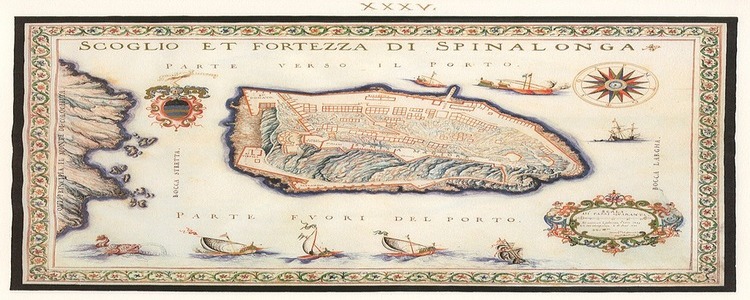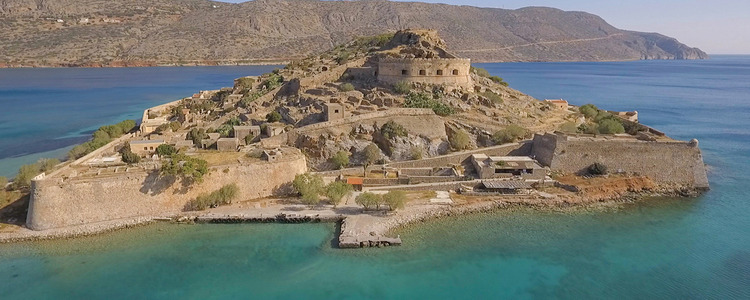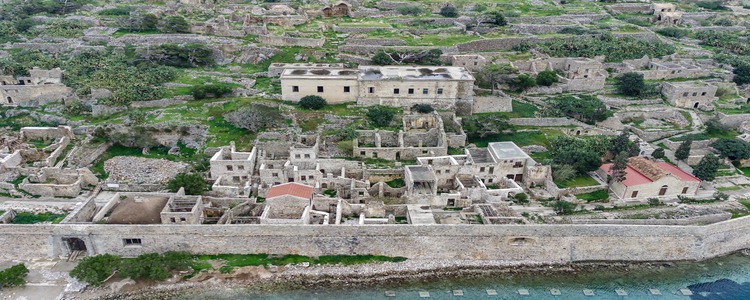
Spinalonga has an area of 85 acres and an altitude of 53 meters and is located at the north entrance of Elounda Bay. The island was originally fortified in antiquity, most probably during the Hellenistic period (323 BC-30 BC), with a large fortified en-closure, in order to protect the entrance to the port of the ancient city of Olous.
Olous and the wider area in general were deserted in the 7th century, due to the Ar-ab invasions into the Mediterranean.
The city was abandoned until the middle of the 15th century, when the Venetians took advantage of the area to collect salt from the salty waters of the gulf. Thus, the area gained considerable value as a commercial centre and became systematically inhabited.
The ancient name of the island was Kalydon, but after its occupation by the Vene-tians it was named Spinalonga, which means “long thorn”.
On the ruins of an ancient castle the Venetians built a strong fortress, designed ac-cording to the fortification practice of the bastion system by Genese Bressani and Latino Orsini.

During the Venetian occupation, the fortress was used for military purposes. The buildings that existed inside the fortress covered the needs of the garrison.
During the Cretan War (1645-1669), refugees and revolutionaries (Chainides) fled to Spinalonga and, based on the island, harassed the Turks. However, Spinalonga re-mained in the hands of the Venetians until 1715, when it was conquered by the Turks.
During the first centuries of the Turkish occupation the fortress was marginalized and used as a place of exile and isolation. However, at the end of the 19th century, the facts changed. The role of the port of Spinalonga was upgraded, as it was granted a licence for export trade. In the mid-19th century, a large number of inhabitants, the majority of them merchants and sailors, gathered on the island, taking advantage of the security of the fortified settlement to exploit the trade routes of the Eastern Mediterranean.
The life of this settlement was abruptly interrupted due to the political events that took place in Crete during the last years of the 19th century. The insecurity that pre-vailed among the Turks of Crete due to the revolutionary action of the Christians forced the majority of the inhabitants of Spinalonga to emigrate. From 1897, French military forces were established on the island and for about a year in Spinalonga.
In 1903, however, the Cretan State decided to use the abandoned island for the cre-ation of a leper hospital and to isolate the lepers of Crete there. Initially, 250 patients were transferred there. But after 1913, when Crete was united with Greece, more patients started to arriving from Greece and abroad.

The patients lived in the buildings of the Turkish settlement and in modern buildings constructed in the 1930s. The building activity of the leper house brought dramatic changes to the buildings of the settlement and the fortifications of the fortress.
The difficult life of the patients, who stayed on the island until then, marked the place and charged it emotionally, making it a place of martyrdom and historical memory.
Fortunately, with the progress of medicine and the use of antibiotic drugs, the dis-ease was tackled and the leper house was closed in 1957.
After 1957, the island was left unused for many years, until the 1970s, when restora-tion, repair and improvement work on the Venetian walls, buildings and roads began and is still continuing.
Nowadays the fortress and the city of Spinalonga are in very good condition and the island is visited by thousands of visitors every year and is nominated for inclusion in the UNESCO World Heritage Sites.